Transformer Pre-Commissioning Pre-Commissioning tests
- Get link
- X
- Other Apps
1.1 Core insulation tests
This test is performed to check the insulation between core and ground.
1.2 Operational checks on protection system
Operational checks on:
- Cooler bank (pumps and fans),
- Breathers (silica gel or drycol),
- Temperature gauges (temperature of transformer oil – OTI and the windings temperature – WTI),
- Gas actuated relays (Buchholz, PRD, SPR etc.) and
- Simulation test of protection system.
1.3 Insulation resistance (IR) measurement
Test reveals the condition of insulation (i.e. degree of dryness of paper insulation), presence of any foreign contaminants in oil and also any gross defect inside the transformer (e.g. Failure to remove the temporary transportation bracket on the live portion of tap‐changer part).
Insulation resistance is commonly measured in megohms, (MΩ).
It should be stated, that variations in insulation resistance can be caused by numerous factors including: design, temperature, dryness, and cleanliness of parts, especially of bushings.
When insulation resistance falls below specified value, it can often be brought back to the required value by cleaning and drying. Insulation resistance varies with the applied voltage. Any measurement comparisons should always be carried out at the same voltage.
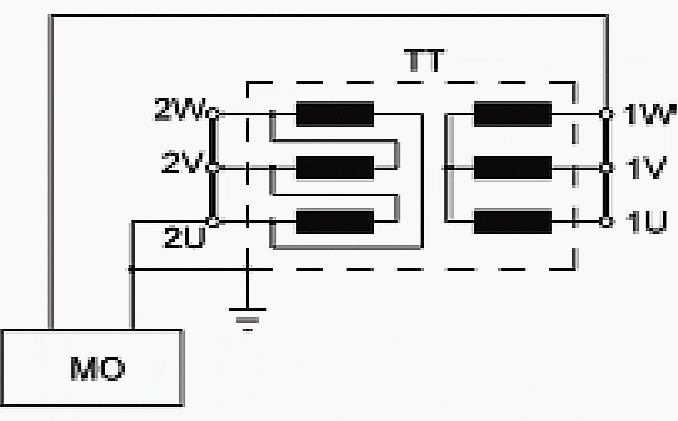
The test is conducted with the help of mega‐ohmmeter. IR is proportional to the leakage current through/over the insulation after capacitive charging and absorption currents become negligible on application of DC voltage.
Insulation resistance shall be measured after the intervals of 15 sec, 60 sec and 600 sec.
The polarization index (PI) is defined as the ratio of IR values measured at the intervals of 600 and 60 seconds respectively. Whereas, the dielectric absorption is the ratio of IR values measured after 60 sec and 15 sec.
IR is normally measured at 5 kV DC or lower test voltage, but the test voltage should not exceed half the rated power‐frequency test voltage of transformer windings.
1.4 Capacitance and dissipation factor (tanδ) measurement of bushings
Capacitance and dissipation factor Tan δ measurement of bushings shall be done at 10kV with fully automatic test kit so as to have reliable test result.
1.5 Capacitance and dissipation factor (tanδ) measurement of windings
The insulation power‐factor test, similar to the insulation resistance test, allows certain conclusions to be drawn concerning the condition of the transformer insulation.
Measurement of power‐factor values in the factory is useful for comparison with field power‐factor measurements and assessing the probable condition of the insulation.
It has not been feasible to establish standard power‐factor values for the following reasons:
- There is little or no relationship between power‐factor and the ability of the Transformer to withstand the
prescribed dielectric tests. - The variation of the transformer temperature is substantial and erratic.
- The various liquids and insulation materials used in transformers result in Large variations in insulation
power factor.
1.6 Turns ratio (Voltage ratio) measurement
To determine the turns ratio of transformers to identify any abnormality in tap changers/ shorted or open turns etc.
Measurement of turn ratio is based on, applying a phase voltage to one of the windings using a bridge (equipment) and measuring the ratio of the induced voltage at the bridge. The measurements are repeated in all phases and at all tap positions, sequentially.
Theoretical turn ratio = HV winding voltage / LV winding voltage
The theoretical no‐load turn ratio of the transformer is adjusted on the equipment by an adjustable transformer. It is changed until a balance occurs on the % error indicator. The value read on this error indicator shows the deviation of the transformer from real turn ratio as %.
% Deviation = 100 x ((Measured TR) ‐ (Designed TR)) / (Designed TR)
Where TR is turn ratio. The % deviation of the turn ratios should be ≤ 0.5 %.
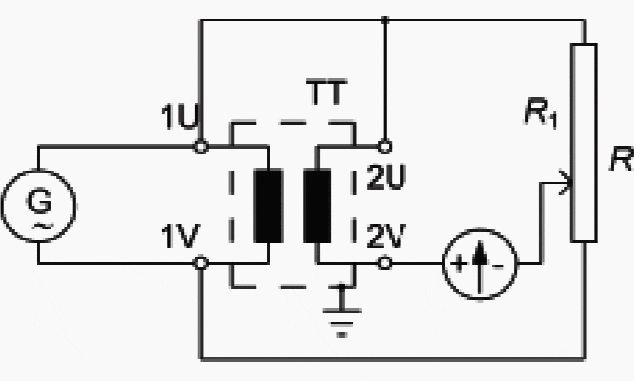
1.7 Vector Group and Polarity
This test is used to determine the phase relationship and polarity of transformers. Depending on the type of the transformer, the input and output windings of a multi‐phase transformer are connected either as star (Y) or delta(D) or zigzag(Z).
The phase angle between the high voltage and the low voltage windings varies between 0⁰ and 360⁰.
Representing as vectors, the HV winding is represented as 12 (0) hour and the other windings of the connection group are represented by other numbers of the clock in reference to the real or virtual point.
Determining the connection group is valid only in three phase transformers. The high voltage winding is shown first (as reference) and the other windings follow it.
If the vector directions of the connection are correct, the bridge can be balanced.
Also, checking the connection group or polarity is possible by using a voltmeter. Direct current or alternating current can be used for this check. The connections about the alternating current method are detailed in standards.
An example of this method is shown on a vector diagram below.
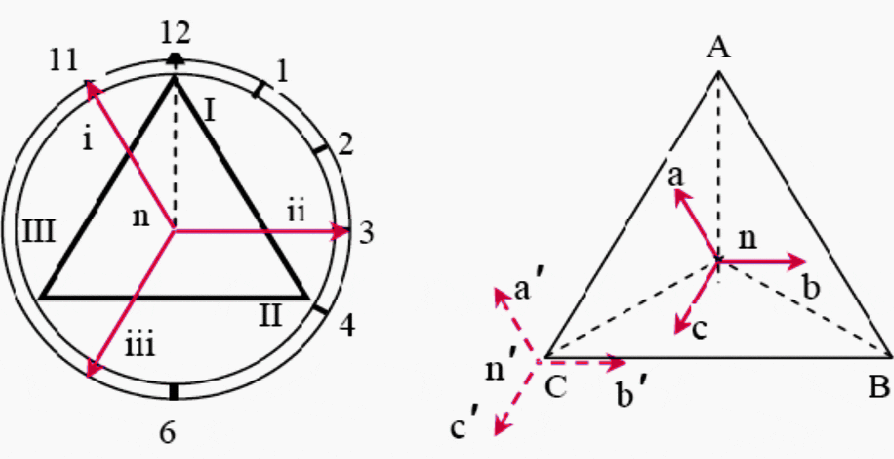
1.8 Winding resistance measurement
To check for any abnormalities due to loose connections, broken strands and high contact resistance in tap changers.
Winding resistance serves a number of important functions like:
- Providing a base value to establish load loss.
- Providing a basis for an indirect method to establish winding temperature and temperature rise within a winding.
- Inclusion as part of an in‐house quality assurance program, like verifying electric continuity within a
winding.
Principle and methods for resistance measurement
There are basically two different methods for resistance measurement:
- So‐called “voltmeter‐ammeter method” and
- The bridge method.
“Voltmeter‐ammeter method”
The measurement is carried out using DC current. Simultaneous readings of current and voltage are taken. The resistance is calculated from the readings in accordance with Ohm’s Law. This measurement may be performed using conventional analog (rarely used nowadays) or digital meters.
However, today digital devices such as Data Acquisition Systems (DAS) with direct resistance display are being used more and more.
The measuring circuit is shown in figure 4.
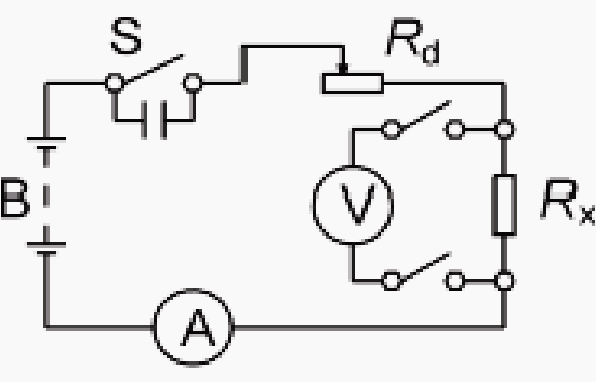
Where:
- RX = Unknown resistance (transformer under test)
- Rd = Regulating resistor
- S = Circuit breaker with protective gap
- B = DC source
Resistance RX is calculated according to Ohm’s Law:
RX = U / I
Resistance measurement using a Kelvin (Thomson) Bridge
This measurement is based on the comparison of two voltage drops: namely, the voltage drop across the unknown winding resistance RX, compared to a voltage drop across a known resistance RN (standard resistor), figure 5.
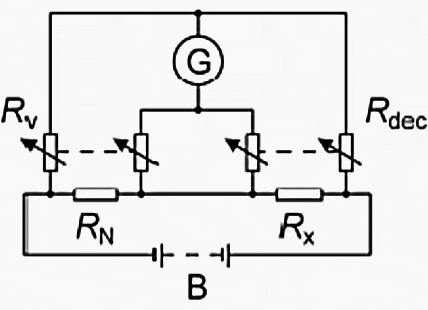
Where:
- RX = Unknown resistance (transformer under test)
- RN = Standard resistor
- Rdec = Decade resistor
- RV = Variable resistor
- G = Galvanometer
- B = DC source
DC‐current is made to flow through RX and RN and the corresponding voltage drops are measured and compared.
The influence of contact resistances and the connection cable resistances (even of the connection between RX and RN) can be neglected.
1.9 Magnetic Balance test
This test is conducted only in three phase transformers to check the imbalance in the magnetic circuit.
In this test, no winding terminal should be grounded. Otherwise results would be erratic and confusing. The test shall be performed before winding resistance measurement. The test voltage shall be limited to maximum power supply voltage available at site.
Evaluation criteria
The voltage induced in the center phase is generally 50% to 90% of the applied voltage on the outer phases. However, when the center phase is excited then the voltage induced in the outer phases is generally 30 to 70% of the applied voltage.
1.10 Floating neutral point measurement
This test is conducted to ascertain possibility of short circuit in a winding.
1.11 Measurement of short-circuit impedance
This test is used to detect winding movement that usually occurs due to heavy fault current or mechanical damage during transportation or installation since dispatch from the factory. Ensure the isolation of transformer from high voltage and low voltage side with physical inspection of open condition of the concerned isolators / disconnectors.
In case tertiary is also connected, ensure the isolation of the same prior to commencement of testing. The measurement is performed in single phase mode.
This test is performed for the combination of two winding. The one of the winding is short circuited and voltage is applied to other winding. The voltage and current reading are noted.
The acceptable criteria should be the measured impedance voltage having agreement to within 3 percent of impedance specified in rating and diagram nameplate of the transformer.
Variation in impedance voltage of more than 3% should be considered significant and further investigated.
1.12 Exciting / Magnetizing current measurement
This test should be done before DC measurements of winding resistance to reduce the effect of residual magnetism. Magnetizing current readings may be effected by residual magnetism in the core.
Therefore, transformer under test may be demagnetized before commencement of magnetizing current test.
Measure phase to phase voltage between the IV terminals and current on each of the IV terminals. The set of reading for current measurement in each of the tap position should be equal. Unequal currents shall indicate possible short circuits in winding.
Results between similar single‐phase units should not vary more than 10 %.
The test values on the outside legs should be within 15 % of each other, and values for the centre leg should not be more than either outside for a three‐phase transformers. Results compared to previous tests made under the same conditions should not vary more than 25%.
The availability of test data of normal condition and faulty condition results help us to analyze the problem in future.
1.13 Vibration measurement of oil‐immersed reactor
This test is performed in order to measure the vibrations of core / coil assembly in the tank of the reactor. Movement of the core‐coil assembly and shielding structure caused by the time–varying magnetic forces results in vibration of the tank and ancilliary equipment.
These vibrations have detrimental effects such as excessive stress on the core‐coil assembly.
1.14 Operational check on OLTCs
The aim of this check is to ensure smooth and trouble free operation of OLTC during operation.
- Get link
- X
- Other Apps







Comments
Post a Comment